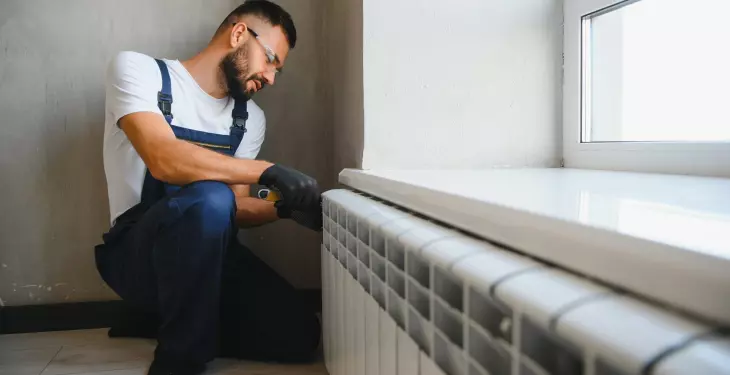



Written by Stephen Day
Gas Safe Engineer
Updated: 1st August, 2025
Heat pumps generally don't require planning permission in the UK, thanks to permitted development rights. However, there are exceptions, particularly for homes in special areas like conservation zones.
See how much you could save with a heat pump quote.
Air source heat pumps (ASHPs) are fast becoming a popular and eco-friendly solution for home heating, but the question on many homeowners' minds is: do you need planning permission to install one? The rules surrounding planning permissions can be a bit tricky, especially with the recent changes to UK regulations in May 2025. Let's break down what you need to know.
An air source heat pump is an energy-efficient system that extracts heat from the outside air, even in colder temperatures, to heat your home and produce hot water. It works similarly to a refrigerator but in reverse, transferring heat from the outdoor air into your home. Air source heat pumps are popular because they are more energy-efficient than traditional heating methods like gas boilers, helping homeowners save on energy bills while reducing their carbon footprint.
There are two main types of ASHPs: air-to-air, which warms the air inside your home, and air-to-water, which works with your existing radiator system or underfloor heating. Both offer great energy savings and contribute to achieving the UK's goal of net-zero carbon emissions by 2050.
In the UK, most homeowners can install an air source heat pump without needing to apply for planning permission, thanks to permitted development rights. These rights make the process simpler, so homeowners can enjoy the benefits of renewable energy with less paperwork. However, as of May 2025, the regulations have changed, and there are some exceptions you should be aware of.
For instance, properties in conservation areas or listed buildings may still need planning permission due to the protected status of these areas. Similarly, the planning rules differ depending on where you live, as local councils can have different interpretations of the guidelines. It's always wise to check with your local authority to be sure.
In a significant update to UK planning law, the requirement for heat pumps to be installed at least one metre from a neighbouring property has been lifted. This change is part of the government’s Warm Homes Plan, which aims to make it easier for homeowners to transition to low-carbon heating solutions. The new regulation removes a major barrier, particularly for those living in terraced homes, where space is often limited. Previously, this one-metre rule meant a lengthy wait for planning permission, which deterred many homeowners from installing heat pumps.
The relaxation of these planning rules comes after industry feedback highlighted how this requirement was slowing the adoption of heat pumps. The government has now dropped this rule in response to concerns over long delays for homeowners who wanted to replace their broken gas boilers.
However, noise restrictions still apply. The heat pump must not exceed specific noise limits to ensure it doesn’t disturb neighbours. Newer models of ASHPs are quieter than earlier versions, so noise is less of an issue, but it’s still something to keep in mind.
While the planning permission rules have relaxed, there are still other factors to consider when installing an ASHP:
Size of the Heat Pump: The heat pump cannot exceed 1.5 cubic metres to be classified as permitted development. Larger systems might require planning permission.
Installation Location: The location of the outdoor unit is critical. It must be installed in a place that ensures efficient operation and minimises any disruption to neighbours. This includes considering the noise levels and distance from boundaries.
Ground Source Heat Pumps (GSHP): If you are considering a ground source heat pump (which requires drilling underground), the rules can be different. These systems often need more space for installation, and the local council might require planning permission, especially if digging involves significant excavation work.
Local Regulations: It's always a good idea to check with your local council or planning department, as different councils may have varying rules about where and how you can install your heat pump. Even with the new guidelines, it’s essential to ensure your installation complies with any specific local restrictions.
The cost of installing a heat pump can vary depending on the type of system and the size of your home. Air source heat pumps typically cost between £10,500 and £13,500 for a standard 3–4 bedroom home. Ground source heat pumps are more expensive, ranging from £28,000 to £40,500 due to the need for underground drilling.
However, the Boiler Upgrade Scheme offers grants of up to £7,500 to help homeowners with the upfront cost of installing a heat pump. This scheme aims to make renewable heating solutions more accessible, especially for people looking to replace outdated and inefficient heating systems.
Yes, installing a heat pump can help reduce your energy bills, but the savings depend on several factors such as your home’s insulation and current heating system. Although the initial installation cost can be high, air source heat pumps are much more efficient than traditional heating systems, saving you money over the long term. A heat pump uses electricity to move heat from the outside air into your home, which is far more efficient than burning fuel. With the UK’s increasing reliance on renewable energy, the cost of running a heat pump should continue to decrease over time.
The government’s goal is to have half of homes using heat pumps by 2040, so the savings and financial incentives are likely to increase as more homes adopt this technology.
Yes, there are a number of options to reduce the financial burden of installing a heat pump. Besides the Boiler Upgrade Scheme, there are other government initiatives, such as the Warm Homes Plan, which can help fund heat pumps in some areas. It's also worth checking with your energy supplier, as some companies offer deals or discounts for customers installing renewable energy systems.
While air source heat pumps offer a cleaner, greener heating solution, they’re not the right fit for every home. You’ll need sufficient outdoor space for the unit, good insulation to maximise efficiency, and to consider the upfront cost of installation. If you're looking to make your home more energy-efficient and reduce your carbon footprint, an air source heat pump is an excellent option to explore.
Always consult with a professional installer to assess your property and ensure you're getting the most out of your investment. Heat pumps are a fantastic long-term solution for eco-conscious homeowners, especially with the changes in UK planning regulations that make installation easier than ever before.
If you're thinking about making the switch to a heat pump, we’re here to help. Feel free to get in touch for a free quote or advice tailored to your home’s needs.
Last updated: 1st August, 2025

Written by Stephen Day
Gas Safe Engineer at iHeat
Stephen Day is a Gas Safe registered and FGAS certified engineer with over 20 years of hands-on experience in the heating, cooling, and renewable energy industry, specialising in boiler installations, air conditioning, and heat pump systems.
LinkedInArticles by Stephen Day are reviewed by iHeat’s technical team to ensure accuracy and reliability.

05th December, 2025
Most homes need some radiators upgraded for a heat pump, but usually not all of them.
 Read Article
Read Article

05th December, 2025
Most homes can lower heating costs by combining air source heat pumps with solar panels.
 Read Article
Read Article

28th November, 2025
High temperature heat pumps work like boilers without needing radiators, but they cost mor...
 Read Article
Read Article
No obligation. Takes less than 60 seconds.